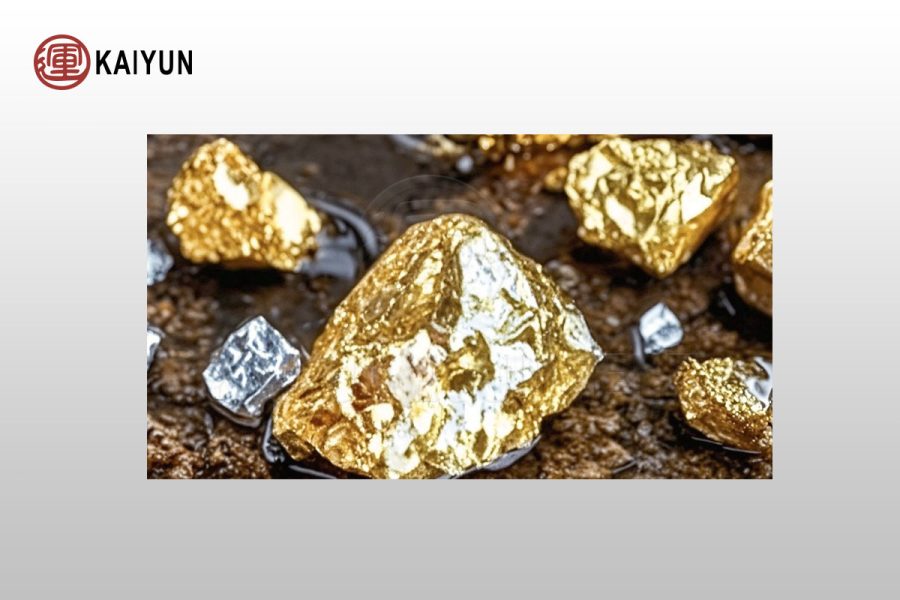Sulfide gold ore usually refers to the type of ore associated with gold and sulfide (such as pyrite FeS₂, arsenopyrite FeAsS, etc.). Since gold is often present in sulfide in the form of fine particles or inclusions, direct cyanide leaching efficiency is low, so a specific beneficiation process is required for pretreatment and enrichment. The following are the main process flow and technical points of sulfide gold beneficiation:
Table of Contents

Conventional sulfide gold beneficiation process
Crushing and grinding
Coarse crushing (jaw crusher) → medium crushing (cone crusher) → fine crushing (high pressure roller mill/ball mill) to make the ore particle size reach monomer dissociation (usually grinding to -200 mesh accounts for more than 80%).
Goal: fully expose the bonding interface between gold and sulfide to create conditions for subsequent sorting.
Flotation enrichment of sulfide
Agent system:
Collector: xanthate (such as butyl xanthate), black medicine, selectively collect sulfide.
Adjusters: lime (pH 9-11, inhibiting gangue), copper sulfate (activating pyrite).
Process: roughing → scavenging → concentrating, obtaining sulfide concentrate (containing gold carrier minerals).
Applicability: Applicable to the situation where gold and sulfide coexist closely but are not completely encapsulated.
Pretreatment of sulfide concentrate
The sulfide concentrate after flotation needs to be further treated to release the encapsulated gold. Common methods include:
(1) Roasting oxidation
Decompose sulfide at high temperature (600-800℃) to generate porous oxides (such as Fe₂O₃) to release the encapsulated gold.
Disadvantages: Produce SO₂ waste gas (need to match the desulfurization system), and may generate As₂O₃ (need to be strictly controlled).
(2) Biological oxidation (BIOX)
Use acidophilic bacteria (such as ferrothiobacillus) to oxidize sulfide, destroy the crystal structure and release gold.
Advantages: environmental protection, low energy consumption; Disadvantages: long cycle (5-7 days), temperature control required (40-45℃).
(3) Pressurized oxidation (POX)
Acidic oxidation of sulfides under high temperature and pressure (180-220℃, 1-2 MPa), high gold dissociation degree.
Applicability: Treatment of high-arsenic, high-sulfur difficult-to-treat gold ores, but large equipment investment.
Cyanide leaching
After regrinding the pretreated concentrate, the conventional cyanidation method (CIL/CIP) is used to leach gold.
Leaching conditions: pH 10-11 (lime adjustment), NaCN concentration 0.03%-0.1%, leaching rate can reach more than 90%.
Special processes and innovative technologies
Gravity separation-flotation combined process
The coarse free gold is first recovered by gravity separation (shaking table, centrifugal concentrator), and the tailings are then floated to remove sulfides.
Advantages: Reduce flotation load and improve overall recovery rate.
Non-cyanide leaching technology
Thiosulfate method: suitable for copper sulfide ores, avoiding the sensitivity of cyanide to copper.
Thiourea method: leaching in acidic medium, strong permeability to encapsulated gold, but high cost.
Flash flotation: flash flotation machine is set in the grinding circuit to give priority to recovering dissociated coarse sulfides to avoid over-grinding.
Key factors for process selection
Ore properties:Gold occurrence (encapsulation rate, particle size), sulfide type (pyrite/arsenopyrite ratio), arsenic content, etc.High arsenic ores should give priority to biological oxidation or pressurized oxidation.
Economical efficiency: small-scale mines tend to roast or bio-oxidation, and large-scale mines can choose pressurized oxidation.
Environmental protection requirements: areas with strict emission restrictions need to adopt biological oxidation or closed POX process.
Typical process examples
Process flow of high arsenic sulfide gold ore:
Ore → crushing → grinding → flotation (sulfide concentrate) → biological oxidation → cyanide leaching → carbon adsorption → electrolytic gold extraction
Process flow of low-sulfur gold ore:
Ore → crushing → grinding → gravity separation (recovery of free gold) → flotation (sulfide) → roasting → cyanide leaching
Technical challenges and development trends
Green process: optimization of biological oxidation technology (selection of arsenic-resistant strains), industrial application of non-cyanide leaching agents.
High-efficiency equipment: ultrafine grinding (vertical mill), microwave pretreatment, etc. to improve gold dissociation efficiency.
Intelligent: process automation control based on mineral gene characteristics.